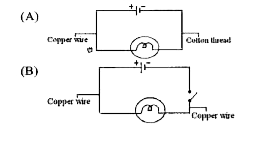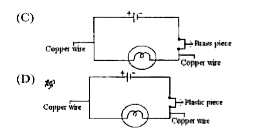Three incandescent bulbs of 100W each are connected in series in an electric circuit. In another circuit, another set of three bulbs of the same wattage are connected in parallel to the same source.
(a) Will the bulbs in the two circuits glow with the same brightness ? Justify your answer.
(b) Now let one bulb in both circuits get fused. Will the rest of the bulbs continue to glow in each circuit ? Give reason.
(a) In a household electric circuits, different appliances are connected in parallel to one another. Give two reasons for the same.
(b) An electrican puts a fuse of rating 5A in that part of domestic electrical circuit in which electrical heater of rating 1.5kW,220V is operating. What iis likely to happen in this case and why ? What change, if any, needs to be made ?
N/A
or
(a) Different appliancies in a household electric circuit are connected in parallel so that :
(i) the appliancies work at the same voltage.
(ii) the appliancies can be operated independent of each other.
(b) Here P=1.5kW=1500W,V=220V
As P=VI,I=PV=1500220=6.81A
When 6.81A current flows through the fuse-wire of rating 5A, it melts and the circuit breaks. This is due to the reason that the current flowing through the fuse, i.e., 6.81A is more than its rating, i.e., A. In this case, a fuse of rating higher than 6.81A (i.e., say 10A) must be used.
Topper's Solved these Questions
- ELECTRICITYBook:PRADEEPChapter:ELECTRICITYExercise:(Mock Test)Sec - B
Explore 6 Videos
- ELECTRICITYBook:PRADEEPChapter:ELECTRICITYExercise:(Exemplar)Multiple Choice
Explore 18 Videos
- MAGNETIC EFFECTS OF ELECTRIC CURRENTBook:PRADEEPChapter:MAGNETIC EFFECTS OF ELECTRIC CURRENTExercise:Mock Test
Explore 21 Videos
Similar Questions
Three incandecent bulbs of 100W each are connected in series in an electric circuit. In another circuit another set of three bulbs of the same wattage are connected in parallel to the same source.
(a) Will the bulbs in the two circuits glow with the same brightness ? Justify your answer.
(b) Now let one bulb in both the circuits get fused. Will the rest of the bulbs continue to glow in each circuit ? Give reason.
View SolutionThree incandescent bulbs of 100 W each are connected in series in an electrical circuit. In another circuit another set of three bulbs of the same wattage are connected in parallel to the same source.
(a) Will the bulb in the two circuits glow with the same brightness? Justify your answer.
(b) Now let one bulb in both the circuits get fused. Will the rest of the bulbs continue to glow in each circuit? Give reason.
View Solution
Knowledge Check
Three electric bulbs of rating 60 W each are joined in series and then connected to electric mains. The power consumed by these three bulbs will be
A180 WB60 WC20 WD203WTwo electric bulbs A and B are rated as 60 W and 100 W . They are connected in parallel to the same source. Then,
AB draws more current than ABCurrent draws are in the ratio of their resistacesCBoth draw the same currentDA draws more current than B.Two electric bulbs A and B are rated as 60 W and 100 W . They are connected in parallel to the same source. Then,
ABoth draw the same currentBA draws more current than BCB draws more current than ADCurrent drawn are in the ratio of their resistances
In which case, bulb glows in the circuit.


View SolutionThree bulbs of 40, 60 and 100 watt are connected in series with the source of 200 volt. Then which of the bulb will be glowing the most –
View SolutionTwo electric bulbs AandB are rated 60and100W, respectively. If they are connected in parallel to the same source , then
View SolutionIn an electrical circuit three incandescent bulbs A,BandC of rating 40W,60Wand100W respectively are connected in parallel to an electric source. Which of the following is likely to happen regarding their brightness ?
View SolutionIn which of these circuits will the bulb glow?
View Solution
